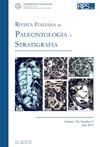PALEOGEOGRAPHIC NORTHEASTERN LIMITS OF APHRODINA DUTRUGEI (COCQUAND, 1862) (HETERODONTA, BIVALVIA) FROM THE CENOMANIAN OF THE ARABIAN PLATFORM
IF 1.6
3区 地球科学
Q2 GEOLOGY
引用次数: 4
Abstract
The finding of Aphrodina dutrugei (Cocquand, 1862) in a rich collection of non-rudist bivalve fauna from the famous Cenomanian-Turonian carbonates of the Afro-Arabian Plate has permitted the reevaluation of venerid bivalves during an important period of their evolution. The genus Aphrodina Conrad, 1869, Family Veneridae Rafinesque, 1815, embraces several Tethyan Cretaceous species that range from Cenomanian to Santonian. During the late Albian-Maastrichtian ‘Aphrodiniid’ venerids, were distributed along the western margin of the Atlantic (North and South America), the Afro-Arabian Plate (Jordan, SE Turkey, Morocco, Algeria and Egypt), the eastern Tethys, and the Southern Ocean (India, Japan, western Australia and New Zealand). They are also known in the Turonian-Santonian Trans-Saharan Seaway (Gabon). Until now these fossils have been unknown in any Upper Cretaceous localities of southeastern Turkey. In this paper, we report the first record of one of the most common and widespread shallow infaunal species, Aphrodina dutrugei, in the Cenomanian Derdere Formation in the Mardin-Mazidagi area, SE Turkey, which is in the extreme northeastern part of its known range.来自阿拉伯地台塞诺曼尼亚的aphrodina dutrugei (cocquand, 1862)(异齿亚目,双壳目)的古地理东北边界
Aphrodina dutrugei (Cocquand, 1862)在非洲-阿拉伯板块著名的Cenomanian-Turonian碳酸盐岩中丰富的非鲁氏双壳类动物群中被发现,使人们能够在其进化的重要时期重新评估venic双壳类动物群。Aphrodina Conrad属,1869年,Veneridae Rafinesque科,1815年,包含了几个特提斯白垩纪的物种,范围从塞诺曼尼亚到圣东尼亚。在阿尔比-马斯垂克晚期,“阿芙罗迪尼”类植物分布在大西洋西部边缘(北美和南美)、非洲-阿拉伯板块(约旦、土耳其东南部、摩洛哥、阿尔及利亚和埃及)、特提斯东部和南大洋(印度、日本、西澳大利亚和新西兰)。它们也被称为Turonian-Santonian跨撒哈拉海道(加蓬)。到目前为止,在土耳其东南部的任何白垩纪晚期地区都没有发现这些化石。本文报道了土耳其东南部Mardin-Mazidagi地区Cenomanian Derdere组中最常见和分布最广的浅水动物之一Aphrodina dutrugei的首次记录,该组位于其已知活动范围的最东北部。
本文章由计算机程序翻译,如有差异,请以英文原文为准。
求助全文
约1分钟内获得全文
求助全文
来源期刊
CiteScore
3.60
自引率
4.30%
发文量
28
审稿时长
>12 weeks
期刊介绍:
The Rivista Italiana di Paleontologia e Stratigrafia was founded in 1895. It publishes original papers dealing with all fields of paleontology and of stratigraphy, from Italy and the Mediterranean to the Tethys, as well across the globe from China to North America.

 求助内容:
求助内容: 应助结果提醒方式:
应助结果提醒方式:


